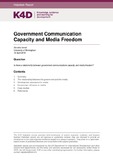| dc.contributor.author | Ismail, Zenobia | |
| dc.date.accessioned | 2019-06-03T13:17:42Z | |
| dc.date.available | 2019-06-03T13:17:42Z | |
| dc.date.issued | 2019-04-16 | |
| dc.identifier.citation | Ismail, Z. (2019). Government Communication Capacity and Media Freedom. K4D Helpdesk Report. Birmingham UK: University of Birmingham. | en |
| dc.identifier.uri | https://opendocs.ids.ac.uk/opendocs/handle/20.500.12413/14506 | |
| dc.description.abstract | The aim of this rapid literature review is to examine the relationship between government communication services and media freedom. However, this relationship receives little mention in the literature on media development and media freedom. Hence, it is very difficult to reach a consensus on the relationship between government communication services and media freedom due to the lack of evidence. Although there is a well-developed literature on media support as part of international development assistance, it makes little reference to the role of government communication services in supporting the development of a free and independent media. Instead, the literature emphasises the watchdog role of the media in terms of fostering transparency and accountability (Deane, 2015). There is limited mention of the relationship between governments and media in the readings on the media ecosystem and open government initiatives supported by the OECD (OECD, 2016a; Ubaldi & Perez, 2018). The literature in this review comprises a mix of academic literature and policy reports produced by the OECD, the World Bank, Centre for Independent Media Assistance (CIMA) and BBC Media Action. The media eco-system includes government, public and private sector media, social media companies, non-governmental organisations (NGOs) and citizens (OECD, 2017). This rapid literature review will focus on the influence of government communication on the government-media relationship. It does not encompass other avenues through which government is able to affect the media environment such as legislation, public policy and political culture. The role of the public media is briefly considered. | en |
| dc.language.iso | en | en |
| dc.publisher | IDS | en |
| dc.relation.ispartofseries | K4D Helpdesk Report;579 | |
| dc.rights.uri | https://www.nationalarchives.gov.uk/doc/open-government-licence/version/3/ | en |
| dc.subject | Governance | en |
| dc.subject | Participation | en |
| dc.subject | Politics and Power | en |
| dc.title | Government Communication Capacity and Media Freedom | en |
| dc.type | Helpdesk | en |
| dc.rights.holder | © DFID - Crown copyright 2019 | en |
| dcterms.dateAccepted | 2019-04-16 | |
| rioxxterms.funder | Department for International Development, UK Government | en |
| rioxxterms.identifier.project | K4D | en |
| rioxxterms.version | VoR | en |
| rioxxterms.funder.project | 238a9fa4-fe4a-4380-996b-995f33607ba0 | en |

